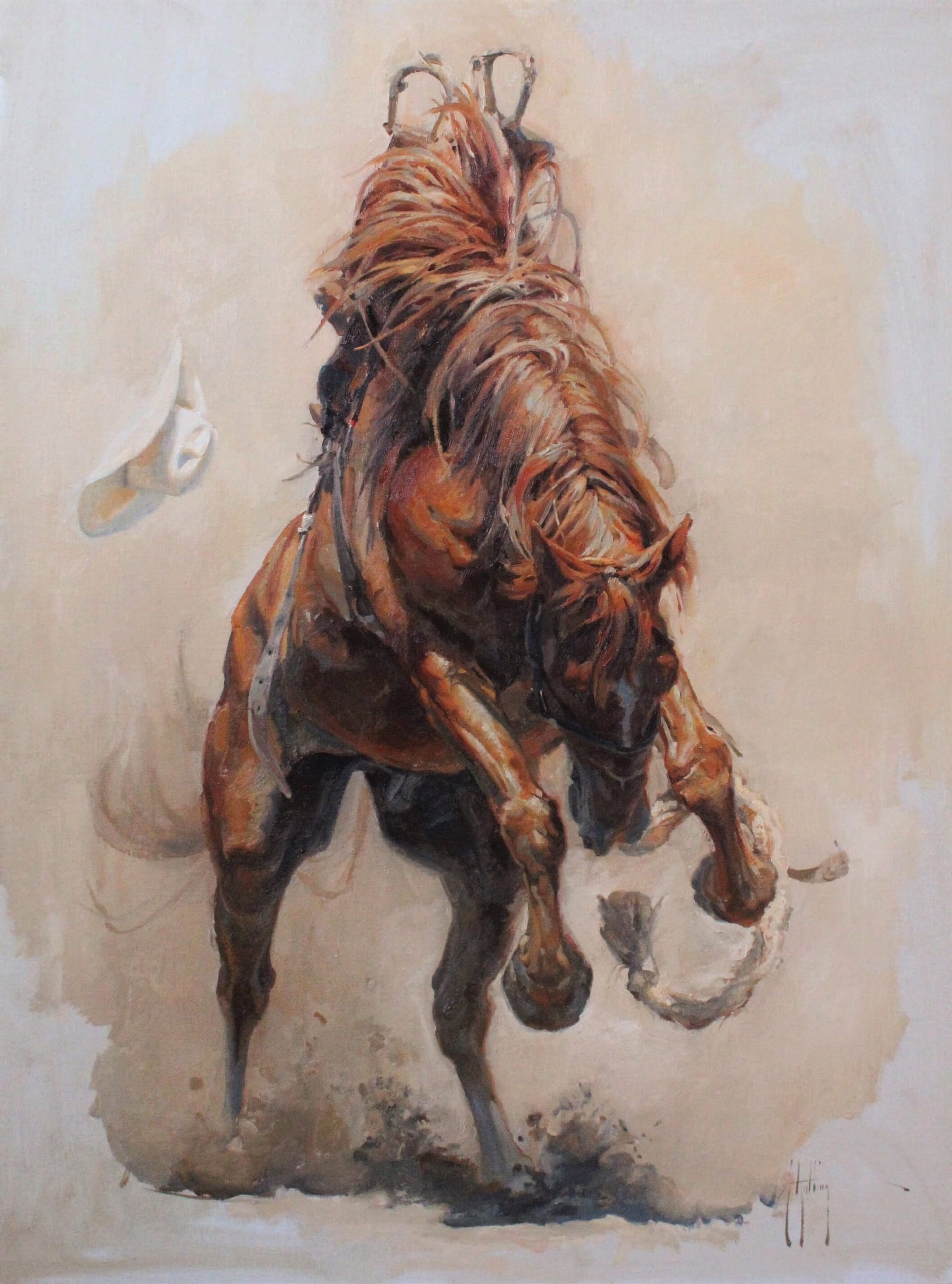
15 Mar From the Rodeo to the Wilderness
Throughout her life, Abigail Gutting cannot remember a time when she was not drawing or painting. The Idaho-based artist has spent the last two decades as a professional painter, “living her dream career.”
She shares a studio with her mother, Susan Gutting, a graduate of the Art Institute of Chicago, a former art teacher, and a well-known landscape artist. She credits her mother for introducing her to the profession and continuing to inspire her.
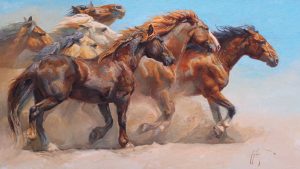
Rush Hour | Oil on Linen | 27 x 48 inches | 2021
Born in Arizona, Gutting moved with her family to rural northern Idaho, where she and her brother were homeschooled. During this time, her mother nurtured the seeds of her imaginative mind. Their idyllic childhood overflowed with learning opportunities through written words and the natural world. For Gutting, the greatest gift of all was exposure to art.
During her later high school years, Gutting’s mother “upped the ante,” switching to more rigorous instruction, using her past assignments from the Art Institute of Chicago and her current works to relay concepts. Oils were outlawed until she could draw. Gutting dabbled in everything from pen and ink, pencil, and gouache to scratchboard, charcoal, and watercolor, before choosing oils as her preferred medium. “I love the richness, texture, and versatility you can get,” she says.
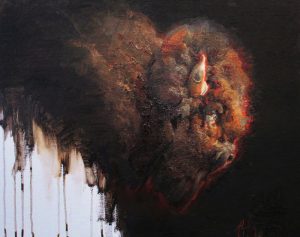
Proceed with Caution | Oil on Linen | 16 x 20 inches | 2023
Throughout her teens and early 20s, Gutting assisted her father in his veterinary practice, which doubled as a classroom to study anatomy. “Dad is still my go-to for an anatomy question,” she says. “It takes him 10 seconds to see if something is off.” The experience also inspired her love of animals.
Throughout her career, Gutting has soaked up instruction at workshops, including studying with Barbara Benedetti Newton at the Frye Museum in Seattle, Washington, and with Ray Roberts, Bruce Greene, and Greg Beecham at the Scottsdale Artists’ School.
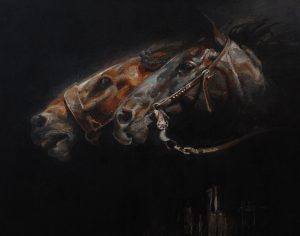
Dark Horse | Oil on Linen | 16 x 20 inches | 2022
Beecham, in particular, became a strong mentor, offering advice on painting wildlife. They share a love of animals and a passion for the West. “He has a way of meeting you where you are at, and making sure you leave at a different level,” Gutting says.
Her precision for detail speaks volumes to admirers of her work and to the gallerists who represent her. Chris McLarry, owner of McLarry Fine Art in Santa Fe, New Mexico, was first drawn to Gutting’s art because her style “expresses what I love in a painting: an area of detail in the center leading outward toward areas of abstraction. To me, this shows the artist possesses a wide range of skill,” he says. “I have also seen a lot of equine paintings, but she really gets the anatomy of the horse.”
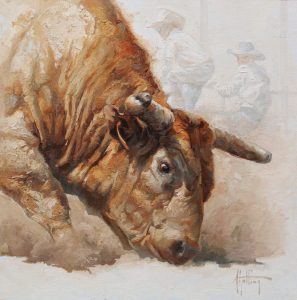
The Bull’s Eye | Oil on Linen | 20 x 20 inches | 2022
Gutting spends a lot of time observing animals in different locales, from horses at rodeos to critters in the wild. “[Beecham] told me animals can always tell you something when you sit and watch them,” she says. Every painting she does portrays a narrative, whether it’s a galloping herd of horses or a trio of cowboys crouched in a huddle, shooting the breeze. “I am drawn to anything that tells a story,” she says.
Her paintings seamlessly blend abstraction and realism, allowing viewers to determine the narrative with their imaginations. She has long been a fan of Norman Rockwell, N.C. Wyeth, and Howard Pyle from the Golden Age of Illustration, whose work she has studied in detail.
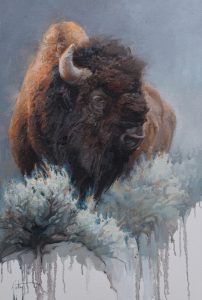
Battleworn | Oil on Linen | 30 x 20 inches | 2022
Gutting starts her creative process with a sketchbook and photographs to curate an idea. She avoids working in an isolated vacuum and will bounce ideas off her mother. “There is always a need for a fresh perspective, and I can ask her, ‘Hey, would you look at this for a second,’” she says. Sharing a studio works for the duo. “We enjoy each other’s company, and suggestions and critiques are just part of our day,” Susan says.
Gutting thrives on sharing vignettes of life in the West, often depicting horses and cowboys. Much of her work exudes a timeless quality. Elements of modern life are subtly added, like a cowboy taking a break to talk on his cell phone while his saddled horse awaits the next task.
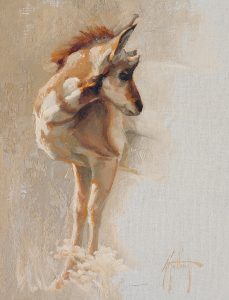
The Young One | Oil on Linen | 12 x 9 inches | 2022
“Her brushwork is methodical so that when you view her paintings up close, they can seem abstract with colors and strokes here and there, but when you step back, it all comes together and gives the viewer a sense of calm,” says Buddy Le, owner of Coeur d’Alene Galleries and partner of the March in Montana Auction. His gallery has represented her work since 2013. “I don’t know how she does it, but she takes a very masculine subject matter, infuses her personality, and softens it up just enough to still capture strength and movement in a graceful way.”
Details are Gutting’s friend. Strong weathered hands gripping a rope or clouds of dirt stirred by galloping hooves allude to the working lifestyle that some believe belongs to a bygone era. “Western traditions are still alive and well today,” she says.

Number 11 | Oil on Linen | 24 x 24 inches | 2021
Over the past two decades, she has amassed a strong following and currently shows her work at Coeur d’Alene Galleries in Coeur d’Alene, Idaho; McLarry Fine Art in Santa Fe, New Mexico; Bozeman Trail Gallery in Sheridan, Wyoming; and as a guest artist at InSight Gallery in Fredericksburg, Texas. In September, her work will be exhibited during Quest for the West Art Show & Sale at the Eiteljorg Museum in Indianapolis, Indiana.
“I think collectors are attracted to Abigail’s work because it exudes quality,” Le says. “There’s an immediate appreciation for her work when people see it for the first time.”
Humble to the core, Gutting’s career ambitions reflect that of an artist known for her meticulous and soulful work. “My goal is to keep moving forward and keep experimenting,” she says. “Ultimately, I want every painting to be better than the last.”






No Comments